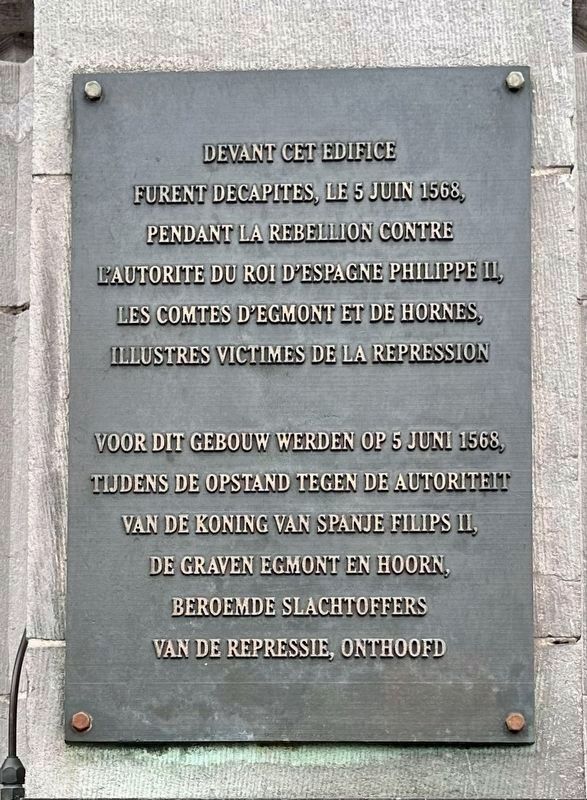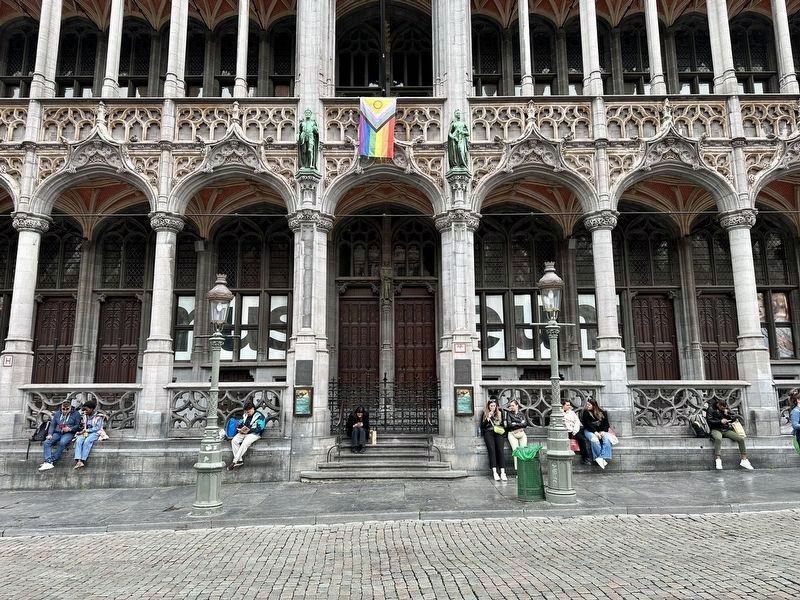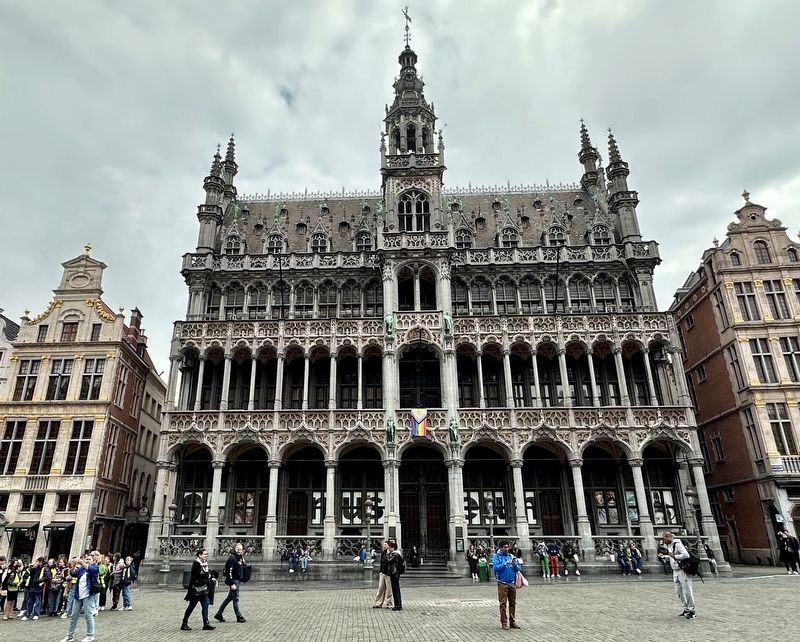Grand Place in Bruxelles, Brussels, Belgium — Northwestern Europe
The Execution of the Counts of Egmont and Horn
Inscription.
Voor dit gebouw werden op 5 juni 1568, tijdens de opstand tegen de autoriteit van de koning van spanje Filips II, de Graven Egmont en Hoorn, beroemde slachtoffers van de repressie, onthoofd
(English translation:)
In front of this building, on June 5, 1568, during the revolt against the authority of the King of Spain Philip II, the Counts Egmont and Hoorn, famous victims of the repression, were beheaded.
Topics. This historical marker is listed in this topic list: Notable Events. A significant historical date for this entry is June 5, 1568.
Location. 50° 50.816′ N, 4° 21.164′ E. Marker is in Bruxelles, Brussels. It is in Grand Place. Marker is on Grand Place, on the right when traveling west. Touch for map. Marker is at or near this postal address: Grand Place 29, Bruxelles, Brussels 1000, Belgium. Touch for directions.
Other nearby markers. At least 8 other markers are within walking distance of this marker. Expulsion of the Austrian Forces (here, next to this marker); Victor Hugo (within shouting distance of this marker); Karl Marx (within shouting distance of this marker); Hôtel de Ville de Bruxelles / Stadhuis van Brussel / The Brussels Town Hall (within shouting distance of this marker); Les Premiers Drapeaux Belges / De Eerste Belgische Vlaggen / The First Belgian Flags (about 90 meters away, measured in a direct line); Verlaine blessa Rimbaud / Verlaine wounded Rimbaud (about 120 meters away); Église Saint-Nicholas / De Sint-Niklaaskerk / The Saint-Nicholas Church / Die Sankt Nikolaus-Kirche (about 120 meters away); Universite Libre de Bruxelles (1834 - 1984) (approx. 0.4 kilometers away). Touch for a list and map of all markers in Bruxelles.
Also see . . . Lamoral, Count of Egmont (Wikipedia).
Excerpt: As a leading Netherlandic nobleman, Egmont was a member of King Philip II of Spain's official Council of State for Flanders and Artois. Together with William, Prince of Orange and the Count of Horn, he protested against the introduction of the inquisition in Flanders…Egmont went to Madrid to beseech Philip II, the king of Spain, for a change of policy in the Netherlands, but met with little more than courtesy… After Philip II sent the Duke of Alba to the Netherlands, William of Orange decided to flee Brussels. Having always declined to do anything that smacked of lèse majesté, Egmont refused to heed Orange's warning; thus he and Horn decided to stay in the city. Upon arrival, Alba almost immediately had the counts of Egmont and Horn arrested on charges of heresy, and imprisoned them in a castle in Ghent, prompting Egmont's wife and their eleven surviving children… to seek refuge in a convent. Pleas for amnesty came to the Spanish king from throughout Europe, including from many reigning sovereigns, the Order of the Golden Fleece (both being knights of the Order, and thereby theoretically immune from trial by any but their peers of the Order), and the king's kinsman the Emperor Maximilian II, all to no avail.(Submitted on June 3, 2023.)
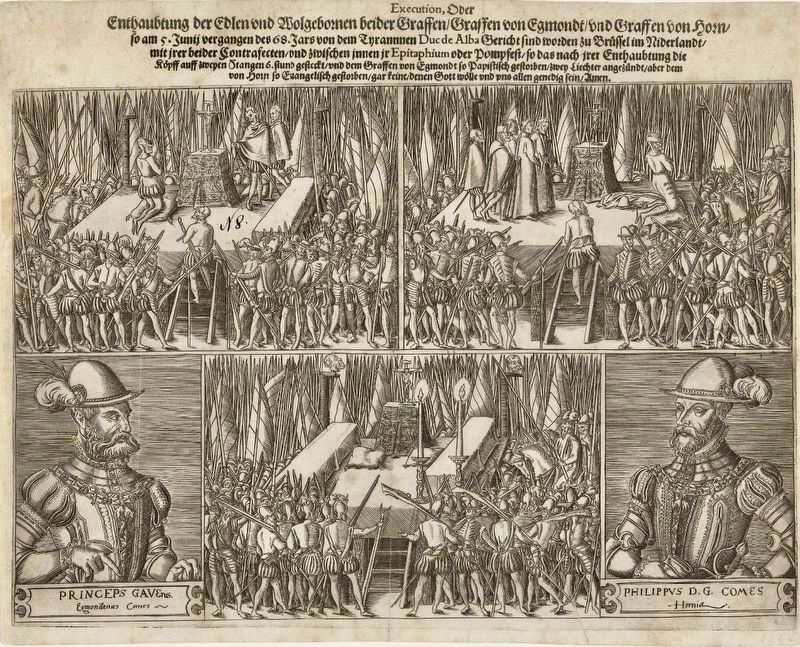
Wolfgang Meyerpeck (courtesy of the Rijksmuseum), 1568
4. The Beheading of Egmont and Horn
On 4 June Egmont and Horn were condemned to death, and lodged that night in the King's House in Brussels. On 5 June 1568 both men were beheaded before the Town Hall on the Grand-Place/Grote Markt (Brussels' main square), Egmont's uncomplaining dignity on the occasion being widely noted. Their deaths led to public protests throughout the Netherlands, and contributed to the resistance against the Spaniards. - Wikipedia
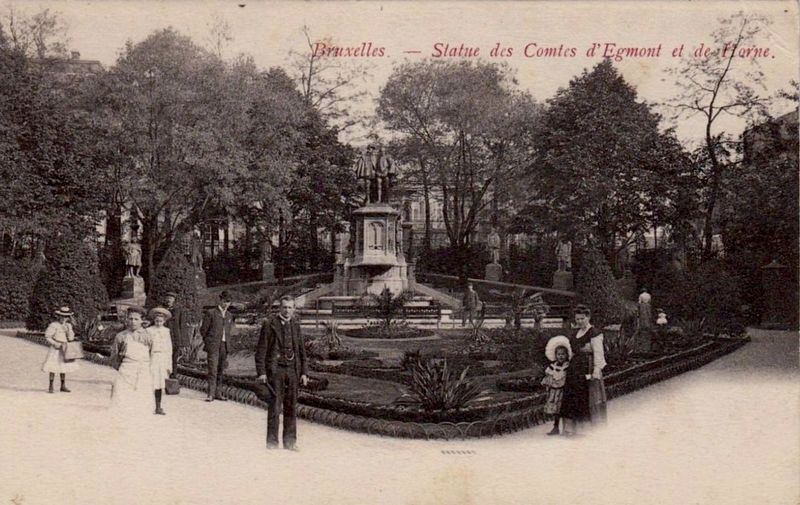
Photographed By Editions J.F.B., circa 1905
5. Bruxelles - Statue des Comtes d’Egmont et de Horne
… Today, a statue on the Square du Petit Sablon/Kleine Zavelsquare in Brussels commemorates the Counts of Egmont and Horn. In historical overview, they are usually mentioned together as Egmond en Hoorne and hailed as the first leaders of the Dutch revolt, as the predecessors of William of Orange, who grew to importance and obtained the rebel leadership after their execution. - Wikipedia
Credits. This page was last revised on December 31, 2023. It was originally submitted on June 3, 2023, by Andrew Ruppenstein of Lamorinda, California. This page has been viewed 344 times since then and 143 times this year. Photos: 1, 2, 3, 4, 5. submitted on June 3, 2023, by Andrew Ruppenstein of Lamorinda, California.
